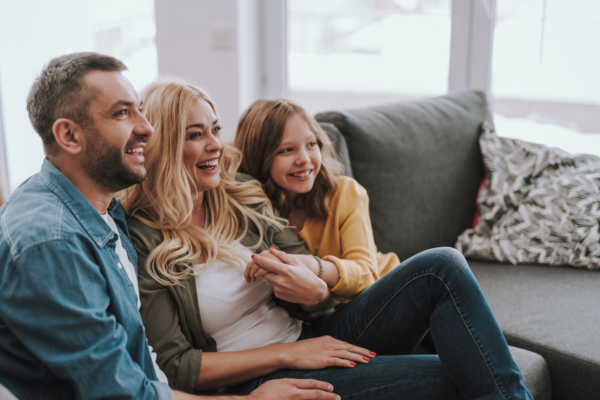.png)
Thermal Dynamics: Comfort All Year Round
Every architect, builder, and interior designer knows that creating a structure is not just about erecting walls and laying foundations. It's about crafting spaces where individuals feel at ease, the outside chaos melts away, and comfort envelops like a familiar embrace. But what defines this comfort? For many, it's the sensation of being just the right temperature: not too hot or cold, but perfectly in between. It's a sensation we often take for granted, yet its presence or absence can drastically shape our experience of a space. Welcome to the world of thermal comfort – where artistry meets science and buildings transform from mere structures to sanctuaries of well-being. Join us as we unravel the mysteries of how buildings keep us warm in winter and cool in summer, making every moment indoors an experience of comfort.

The Science Behind Thermal Comfort
The concept of thermal comfort goes beyond just feeling warm in winter and cool in summer; it's a delicate balance shaped by a complex interplay of environmental and personal factors. But to truly understand and appreciate this balance, we must first delve into the science that underpins it.
At its core, thermal comfort is about the human body's ability to regulate temperature. Our bodies continually produce heat, primarily from metabolic processes. For us to feel comfortable, this heat must be balanced by an equivalent amount of heat loss, which occurs mainly through radiation, convection, evaporation, and conduction.
Imagine stepping into a chilly room. The body, sensing the drop in temperature, will try to reduce heat loss. It does this by constricting blood vessels, thus retaining warmth. On the other hand, if you were to walk into a steamy, humid environment, your body would respond by sweating, attempting to lose heat through evaporation. But, if the air is too humid, this sweat won't evaporate, making you feel hotter and sticky. It's a dynamic dance between the body and its surroundings, with each move designed to maintain a comfortable internal temperature.
Now, couple this with external factors. The temperature of the air around us, the speed at which it moves, its humidity, and the radiant temperature of our surroundings all play pivotal roles. Then, there are more subtle elements like our clothing and activity levels. A thick sweater might be perfect for a stroll in the park on a brisk morning but could become unbearably warm indoors.
While most discussions on thermal comfort focus on the ambient temperature, the radiant temperature is just as crucial. It's the temperature we feel from the surfaces around us. This is why standing in direct sunlight on a sunny winter day can feel warm even if the air is cold. The sunlight increases the radiant temperature, providing comfort despite the chilly surroundings.
It's also essential to recognize that comfort is subjective. Two individuals in the same room might have entirely different perceptions of comfort. Factors like metabolic rate, personal preference, and past experiences can shape our comfort thresholds. What feels chilly to one person might be pleasantly cool to another. This variability is one reason why designing spaces catering to everyone's thermal comfort can be challenging.
Thermal comfort is a fascinating blend of biology, physics, and personal perception. It's a world where science meets sensation, where the tangible elements of temperature and air blend with the intangible feelings of comfort and well-being. As we continue to explore and understand this interplay, we become better equipped to create spaces that shelter us and resonate with our innate need for comfort.

Harnessing Materials for Optimal Comfort
The walls surrounding us and the roofs that shelter us do more than define our spaces; they are silent guardians of our comfort. At the heart of this comfort are carefully selected materials, each with a unique relationship to heat and cold.
Historically, natural materials have dominated the architectural landscape. Think of the cool interior of a stone cathedral on a hot summer day. The stone's dense nature means it can absorb significant heat without its temperature rising noticeably. As day turns to night, this stored heat is released slowly, keeping the interiors warm as the outside cools. Similarly, brick constructions, commonly seen across various cultures and climates, use this material's porous nature and thermal mass to buffer against external temperature fluctuations and regulate internal humidity.
Then there's wood, a favorite in many traditional and modern homes. Beyond its rustic charm and structural benefits, wood is a natural insulator. Its cellular structure traps air, making it an effective barrier against both the cold of winter and the heat of summer.
But as technology advances, the architectural world isn't just looking to the past; it's forging the future. Materials that once seemed fit only for science fiction are making their mark on contemporary designs. Take aerogels, for instance. Often referred to as "frozen smoke" due to their ethereal appearance, these materials, while being incredibly light, offer exceptional insulation. Their origins trace back to aerospace technology, but they're finding their place in groundbreaking architectural projects today.
Another marvel of modern material science is Phase Change Materials (PCMs). These fascinating substances oscillate between solid and liquid states, absorbing and releasing heat. When integrated into building materials, PCMs can help stabilize indoor temperatures, absorbing excess heat during hot periods and releasing it when it gets cooler.
And who could ignore the transformative potential of green or living roofs? Though not a "material" in the traditional sense, the layer of vegetation atop buildings offers both insulation and a natural cooling effect. As cities grapple with the heat island effect, these roofs stand as a testament to the blend of nature and architecture in service of comfort.
But the story of materials isn't just about individual heroes; it's about the ensemble. Systems that combine one material's strength with another's insulating properties, like Insulated Concrete Forms (ICFs), offer the best of both worlds. Similarly, advancements in window designs, with multiple glazings and inert gases, go beyond mere aesthetics, dramatically reducing heat transfer and elevating interior comfort.
As we navigate the maze of modern architecture, the choices of materials are pivotal. They don't just shape our spaces but define our experiences. Whether embracing the wisdom of the past with stone and wood or charting the future with aerogels and PCMs, the quest for thermal comfort is a tale as old as civilization itself. And with each brick laid and each beam raised, we get one step closer to perfecting that tale.

Modern Techniques Elevating Comfort
In an era where innovation continually pushes boundaries, the quest for thermal comfort in buildings takes on new dimensions. It's not just about the materials anymore; it's about how they're used, the techniques employed, and the visionary approaches architects and builders adopt to ensure spaces remain sanctuaries, regardless of the weather outside.
Dive into modern construction, and you're immediately struck by the ingenuity with which traditional practices are being enhanced. For instance, passive solar design isn't a new concept, but its application today is refined. By carefully orienting a building and incorporating features like overhangs and strategically placed windows, architects can harness the sun's energy during winter while shading interiors from excessive heat in the summer. It's a dance of light and shadow, warmth and coolness, seamlessly choreographed for optimal comfort.
Another breakthrough is the intelligent use of green spaces within buildings. Vertical gardens, both inside and out, offer a visual respite in urban landscapes and help modulate indoor climates. These vertical swathes of green act as natural air filters, cooling the surroundings during the heat and adding a layer of insulation when it's cold.
While often invisible to the average person, building management systems play a colossal role in modern thermal comfort. Sensors integrated throughout buildings constantly monitor temperature, humidity, and other environmental factors. Connected to advanced HVAC systems, they ensure that air quality remains pristine and temperatures are consistently comfortable, adjusting in real time to external conditions and internal needs.
Of course, there's also the revolutionary influence of technology. Smart thermostats, for instance, learn from inhabitants' preferences. They adjust heating or cooling not just based on the present but predictively, anticipating the needs of the hour. Then there are innovations like electrochromic windows, which can change their transparency based on external light conditions, thus maintaining a steady internal temperature without blinds or shades.
And let's remember the human element in all of this. Beyond technology and techniques, the emphasis on occupant well-being drives a more holistic approach to design. It's a recognition that comfort isn't just about temperature. It's about creating spaces that nourish the soul, spaces where light, air, and nature intermingle seamlessly with brick, steel, and glass.
Modern techniques in architecture and construction are less about battling nature and more about partnering with it. By understanding the natural world's rhythms and marrying them with cutting-edge technology, we're crafting environments that stand as havens of comfort now more than ever.
Conclusion: A Symphony of Science and Art
Maintaining thermal comfort is a blend of science, art, and a touch of ingenuity. As climate change introduces new challenges, ensuring the spaces we inhabit keep us comfortable becomes ever more crucial. It's a testament to human creativity and adaptability that, even in the face of such challenges, we continue to refine and reinvent how our buildings embrace us, offering warmth in winter and coolness in summer.
Whether constructing a new space or retrofitting an old one, understanding and prioritizing thermal comfort enhances livability and emphasizes sustainability. After all, a building that naturally maintains its temperature reduces the need for external energy inputs, playing a small but significant role in the battle against global warming.
Ultimately, as you cozy up during a winter storm or retreat from the summer sun into a cool room, take a moment to appreciate the marvel of design and engineering that makes it all possible. In their silent, steadfast manner, buildings are more than mere shelters; they're a testament to human resilience and innovation.
From design to dollar – BidLight has got you covered. Get started now ➡️ www.bidlight.com